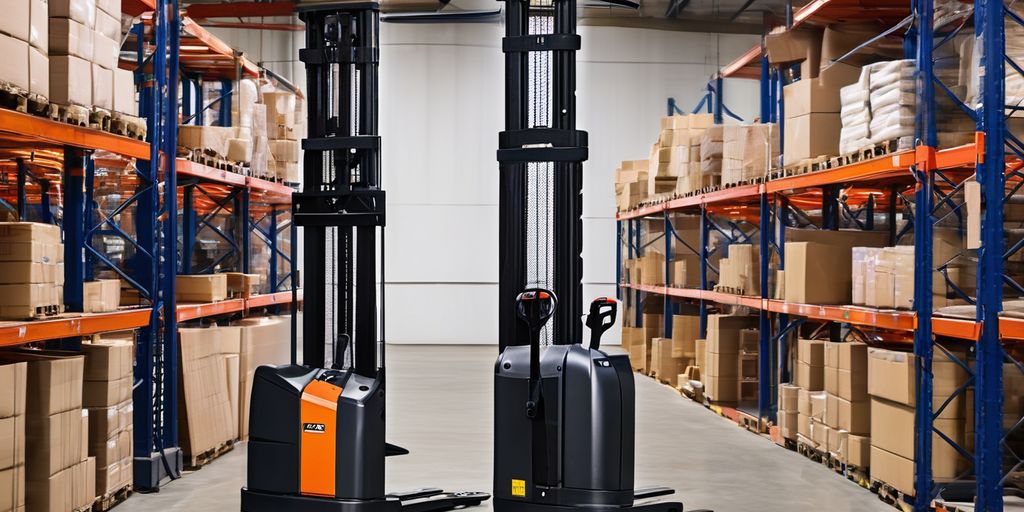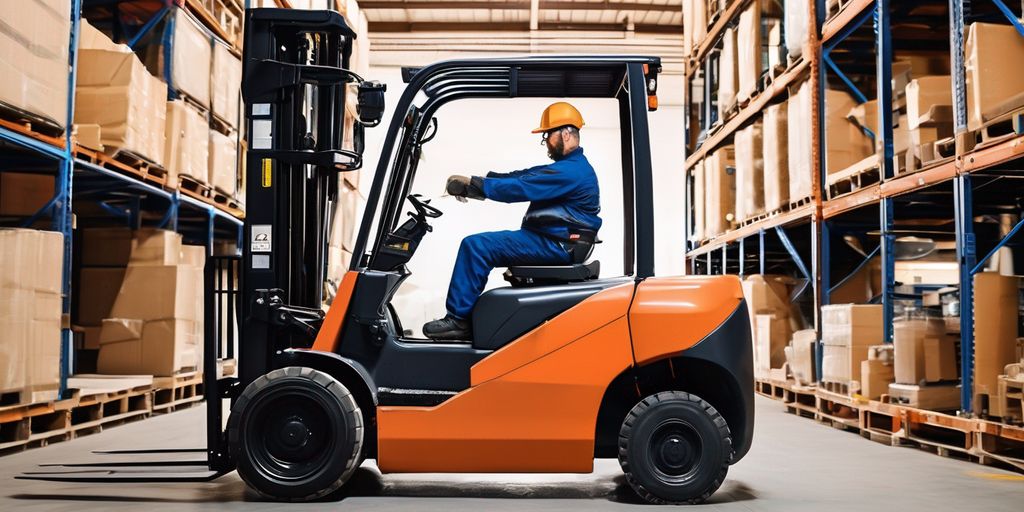Imagine la libertad de no preocuparse por averías inesperadas o accidentes relacionados con carretillas elevadoras. Una flota bien mantenida, junto con una asociación sólida, le permite lograr el máximo rendimiento, optimizar costos y crear un entorno de trabajo más seguro para todos. Dé el primer paso para lograr esta visión: implemente una sólida estrategia de mantenimiento hoy y observe cómo su flota de montacargas se convierte en un verdadero activo que impulsa su negocio.
Conclusiones clave
- La implementación de prácticas de mantenimiento preventivo ayuda a minimizar el tiempo de inactividad y prolongar la vida útil del equipo.
- Cumplir con las pautas del fabricante y realizar inspecciones periódicas es crucial para mantener el rendimiento del montacargas.
- La capacitación del operador es esencial para garantizar un manejo adecuado y la detección temprana de posibles problemas.
- Asociarse con un proveedor de mantenimiento ofrece experiencia, soluciones rentables y cumplimiento de los estándares de seguridad.
- La optimización de los flujos de trabajo mediante el diseño estratégico y la integración de tecnología impulsa la eficiencia general.
La importancia del mantenimiento preventivo
El mantenimiento preventivo es crucial para garantizar la longevidad y el rendimiento óptimo de los montacargas. Siguiendo un plan preventivo programado, las empresas pueden evitar problemas inesperados y mantener la vida económica de sus equipos.
Reducir el tiempo de inactividad inesperado
La implementación de mantenimiento preventivo ayuda a la detección temprana y la corrección de problemas potenciales antes de que se conviertan en problemas mayores. Este enfoque proactivo reduce el riesgo de tiempos de inactividad inesperados y reparaciones costosas.
Extensión de la vida útil del equipo
Las tareas de mantenimiento regulares, como lubricación, ajustes y reemplazo de componentes, son esenciales para extender la vida útil de los montacargas. Al abordar los problemas menores con prontitud, los montacargas pueden operar de manera más confiable y experimentar menos averías con el tiempo.
Mejorando los estándares de seguridad
El mantenimiento preventivo es esencial para mantener el buen funcionamiento de sus montacargas y reducir el tiempo de inactividad, pero realizar el mantenimiento de maquinaria pesada puede ser un trabajo peligroso. Las inspecciones y el mantenimiento regulares garantizan que todas las características de seguridad funcionen correctamente, mejorando así los estándares generales de seguridad.
Errores Comunes en el Mantenimiento de Montacargas
Ignorando las pautas del fabricante
Uno de los errores más frecuentes es ignorar las recomendaciones del fabricante , que están diseñadas para garantizar que la carretilla elevadora funcione de manera eficiente y segura. No cumplir con estas recomendaciones puede provocar un desgaste prematuro e incluso anular las garantías.
Negligencia en las Inspecciones Regulares
Las inspecciones periódicas son cruciales para identificar posibles problemas antes de que se conviertan en problemas importantes. Desatender estas inspecciones puede provocar averías inesperadas y reparaciones costosas. Un enfoque proactivo de las inspecciones puede ahorrar tiempo y dinero a largo plazo.
Supervisión de la Capacitación de Operadores
La capacitación adecuada del operador es esencial para una operación segura y eficiente del montacargas. Pasar por alto este aspecto puede provocar accidentes y daños en el equipo. Garantizar que todos los operadores estén bien capacitados y actualizados con los últimos protocolos de seguridad es un componente clave para un mantenimiento eficaz de los montacargas.
Abordar estos errores comunes a menudo puede marcar la diferencia entre un montacargas eficiente y bien mantenido y un sistema que no logra desarrollar su potencial.
Estrategias de Mantenimiento Proactivo
Implementando un Programa de Mantenimiento
El mantenimiento proactivo implica programar inspecciones, servicios y reparaciones de rutina durante los períodos de inactividad planificados. Al abordar de manera proactiva las necesidades de mantenimiento , las organizaciones pueden minimizar el tiempo de inactividad no planificado causado por averías inesperadas o fallas de los equipos, maximizando la eficiencia operativa y la productividad.
Uso de una lista de verificación de mantenimiento de montacargas
Una lista de verificación completa de mantenimiento de montacargas garantiza que todos los componentes críticos se inspeccionen y se les dé mantenimiento de manera regular. Esta lista de verificación debe incluir tareas como inspecciones periódicas, limpieza, lubricación y reemplazo de piezas desgastadas. Recuerde que el mantenimiento proactivo es clave para ahorrar dinero a largo plazo.
Monitoreo y análisis de datos de desempeño
El uso de técnicas de mantenimiento predictivo, como el monitoreo de condiciones y el análisis predictivo, puede ayudar a identificar problemas potenciales antes de que se conviertan en problemas mayores. Al monitorear y analizar los datos de rendimiento, las organizaciones pueden implementar medidas preventivas para extender la vida útil de las carretillas elevadoras y reducir el tiempo de inactividad inesperado y las reparaciones costosas .
Implementar un programa de mantenimiento que incluya inspecciones periódicas, limpieza, lubricación y reemplazo de piezas desgastadas ayudará a extender la vida útil de sus activos y reducir el tiempo de inactividad inesperado y las reparaciones costosas.
Beneficios de asociarse con un proveedor de mantenimiento

Asociarse con un proveedor de mantenimiento confiable puede ser una decisión estratégica que ofrece varias ventajas. Al asociarse con un proveedor de mantenimiento confiable, obtiene acceso a una gran experiencia y soporte continuo. Esto le permite concentrarse en administrar su negocio con la tranquilidad de saber que su flota de montacargas está en buenas manos.
Optimización de las operaciones de montacargas
Optimizar los flujos de trabajo y agilizar las operaciones es crucial para maximizar la productividad de los montacargas. Se pueden emplear varias estrategias para lograr este objetivo. En primer lugar, analizar y reorganizar la distribución del almacén puede minimizar las distancias de viaje, reducir la congestión y optimizar el flujo de materiales. Al colocar estratégicamente los elementos de acceso común más cerca del punto de uso, los operadores de montacargas pueden minimizar el tiempo dedicado a buscar y transportar mercancías.
Entendiendo las Regulaciones de OSHA
La Administración de Salud y Seguridad Ocupacional (OSHA) establece y hace cumplir estándares regulatorios para mantener seguros a los trabajadores, siendo la seguridad de los montacargas uno de los aspectos más cruciales en diversas industrias. El cumplimiento de las regulaciones de OSHA no es negociable. Garantizar que todo el personal de mantenimiento esté adecuadamente capacitado y sea consciente de las últimas normas de seguridad es esencial para un entorno de trabajo seguro. La capacitación debe cubrir el uso y la inspección adecuados de los montacargas, la comprensión de los programas de mantenimiento y el conocimiento de los signos comunes de desgaste. Un equipo bien capacitado puede identificar y abordar eficazmente los problemas en forma temprana, contribuyendo significativamente a la seguridad general.
Cumpliendo con los estándares de seguridad
Las regulaciones de OSHA para camiones industriales motorizados cubren una amplia gama de temas de seguridad diseñados para garantizar que los montacargas estén listos y sean capaces de realizar trabajos de manera segura. El cumplimiento proactivo y responsable de estas regulaciones genera menos accidentes, incidentes con tiempo perdido y operaciones más seguras.
Evitando Multas y Sanciones
El incumplimiento de las regulaciones de OSHA puede resultar en multas y sanciones importantes. Las inspecciones periódicas y la documentación adecuada son cruciales para demostrar el cumplimiento y evitar estas costosas repercusiones.
Garantizando un Entorno de Trabajo Seguro
Un entorno de trabajo seguro se logra mediante el estricto cumplimiento de las normas de OSHA y la capacitación continua. Mantenerse al día con la evolución de las regulaciones y reforzar los hábitos seguros a través de recordatorios periódicos y capacitación de actualización garantiza que los operadores se mantengan actualizados sobre los últimos protocolos de seguridad y requisitos regulatorios.
Maximizando el rendimiento de la carretilla elevadora
Lubricación y Ajustes Regulares
La lubricación y los ajustes regulares son esenciales para mantener un rendimiento óptimo de las carretillas elevadoras. Una lubricación adecuada minimiza el desgaste y garantiza que todas las piezas móviles funcionen sin problemas. Los ajustes regulares ayudan a mantener la alineación y el funcionamiento correctos de los distintos componentes, lo que es crucial para maximizar la eficiencia en la gestión de flotas de carretillas elevadoras .
Detección temprana de problemas
La detección temprana de problemas puede evitar que problemas menores se conviertan en reparaciones importantes. Las inspecciones y el monitoreo de rutina pueden ayudar a identificar problemas potenciales antes de que causen un tiempo de inactividad significativo. Este enfoque proactivo no sólo mejora la seguridad sino que también contribuye a la eficiencia general de las operaciones del montacargas.
Reemplazos de Componentes
El reemplazo oportuno de componentes es vital para mantener la confiabilidad y el rendimiento de los montacargas. Con el tiempo, algunas piezas pueden desgastarse y ser necesario reemplazarlas para garantizar que el equipo siga funcionando de manera eficiente. El uso de piezas de repuesto de alta calidad y el cumplimiento de las directrices del fabricante pueden prolongar significativamente la vida útil de los montacargas.
Al invertir tanto en programas de capacitación como en mantenimiento preventivo, las empresas pueden crear una fuerza laboral calificada capaz de operar montacargas de manera segura y eficiente.
Conclusión
Imagine la libertad de no preocuparse por averías inesperadas o accidentes relacionados con carretillas elevadoras. Una flota bien mantenida, junto con una asociación sólida, le permite lograr el máximo rendimiento, optimizar costos y crear un entorno de trabajo más seguro para todos. La implementación de prácticas de mantenimiento preventivo ayuda a minimizar el tiempo de inactividad y prolongar la vida útil del equipo. Al adoptar estas mejores prácticas y estrategias, las empresas pueden desbloquear todo el potencial de sus operaciones con montacargas, reducir costos, mejorar la productividad y obtener una ventaja competitiva en el mundo en constante evolución del manejo de materiales. Dé el primer paso para lograr esta visión: implemente una sólida estrategia de mantenimiento hoy y observe cómo su flota de montacargas se convierte en un verdadero activo que impulsa su negocio.
Preguntas frecuentes
¿Por qué es importante el mantenimiento preventivo de los montacargas?
El mantenimiento preventivo es crucial para minimizar el tiempo de inactividad, extender la vida útil del equipo y mejorar los estándares de seguridad. Ayuda a identificar problemas potenciales antes de que se conviertan en problemas importantes, lo que garantiza que el montacargas funcione de manera eficiente y confiable.
¿Cuáles son los errores comunes que se deben evitar en el mantenimiento de montacargas?
Los errores comunes incluyen ignorar las pautas del fabricante, descuidar las inspecciones periódicas y pasar por alto la capacitación de los operadores. Estos descuidos pueden provocar averías inesperadas, reducción de la vida útil del equipo y mayores riesgos de seguridad.
¿Cómo puedo implementar una estrategia de mantenimiento proactivo para mi flota de montacargas?
Implementar un programa de mantenimiento, utilizar una lista de verificación de mantenimiento del montacargas y monitorear los datos de desempeño son estrategias clave. Estas prácticas ayudan a garantizar un mantenimiento regular y la detección temprana de problemas, lo que contribuye al rendimiento óptimo del montacargas.
¿Cuáles son los beneficios de asociarse con un proveedor de mantenimiento?
Asociarse con un proveedor de mantenimiento ofrece acceso a experiencia y soporte, soluciones rentables y garantiza el cumplimiento de los estándares de seguridad. Esta asociación puede ayudar a agilizar los procesos de mantenimiento y mejorar la eficiencia operativa general.
¿Cómo afecta el cumplimiento de las regulaciones de OSHA al mantenimiento de los montacargas?
Cumplir con las regulaciones de OSHA garantiza un ambiente de trabajo seguro, ayuda a evitar multas y sanciones y promueve el cumplimiento de las normas de seguridad. También contribuye a la fiabilidad y seguridad general de la flota de carretillas elevadoras.
¿Cuáles son algunos consejos para maximizar el rendimiento del montacargas?
La lubricación y los ajustes regulares, la detección temprana de problemas y el reemplazo oportuno de componentes son esenciales. Estas prácticas ayudan a mantener un rendimiento óptimo, reducir el riesgo de averías y prolongar la vida útil de los montacargas.




Deja un comentario
Este sitio está protegido por hCaptcha y se aplican la Política de privacidad de hCaptcha y los Términos del servicio.